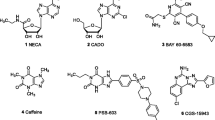Abstract
The fluorescein conjugate, FITC-APEC (2-[2-[4-[2-[2-[1,3-dihydro-1,1-bis(4-hydroxyphenyl)-3-oxo-5-isobenzofuranthioureidyl]ethylaminocarbonyl]ethyl] phenyl]ethylamino]-5′-N-ethylcarboxamidoadenosine), is a novel ligand derived from a series of functionalized congeners that act as selective A2a-adenosine receptor agonists. The binding of FITC-APEC to bovine striatal A2a-adenosine receptors measured by fluorescence techniques was saturable and of a high affinity, with aB max of 2.3±0.3 pmol/mg protein andK D of 57±2 nM. TheK D value estimated by fluorescence was consistent with theK i (11±0.3 nM) obtained by competition studies with [3H]CGS 21680. Additionally, theB max value found by FITC-APEC measurement was in agreement withB max values obtained using radioligand binding. FITC-APEC exhibited rapid and reversible binding to bovine striatum. The potencies of chemically diverse A2a-adenosine receptor ligands estimated by inhibition of FITC-APEC binding were in good agreement with their potencies determined using radioligand binding techniques (r=0.97,P=0.0003). FITC-APEC binding was not altered by purine derivatives that do not recognize A2a-adenosine receptors. These findings demonstrate that the novel fluorescent ligand FITC-APEC can be used in the quantitative characterization of ligand binding to A2a-adenosine receptors.
Similar content being viewed by others
References
H. I. Yamamura, S. J. Enna, and M. J. Kuhar (1983)Neurotransmitter Receptor Binding, Raven Press, New York.
S. H. Snyder (1989)JAMA 261, 3126–3129.
R. T. McCabe, B. R. de Costa, R. L. Miller, R. H. Havunjian, K. C. Rice, and P. Skolnick (1990)FASEB J. 4, 2934–2940.
R. H. Havunjian, B. R. de Costa, K. C. Rice, and P. Skolnick (1990)J. Biol. Chem. 265, 22181–22186.
R. T. McCabe, A. H. Newman, and P. Skolnick (1992)J. Pharmacol. Exp. Ther. 262, 734–740.
J. L. Velazquez, C. L. Thompson, E. M. Barnes, and K. J. Angelides (1989)J. Neurosci. 9, 2163–2169.
B. K. Madras, D. R. Canfield, C. Pfaelzer, F. J. Vittimberga, Jr., M. Difiglia, N. Aronin, V. Bakthavachalam, N. Baindur, and J. L. Neumeyer (1990)Mol. Pharmacol. 37, 833–839.
M. J. Ariano, F. J. Monsma, A. C. Barton, H. C. Kang, R. P. Haugland, and D. R. Sibley (1989)Proc. Natl. Acad. Sci. USA 86, 8570–8574.
F. J. Monsma, Jr., A. C. Barton, H. C. Kang, D. L. Brassard, R. P. Haugland, and D. R. Sibley (1989)J. Neurochem. 52, 1641–1644.
A. C. Barton, H. C. Kang, M. S. Rinaudo, F. J. Monsma, R. M. Stewart-Fram, J. A. Macinko, Jr., R. P. Haugland, M. A. Ariano, and D. R. Sibley (1991)Brain Res. 547, 199–207.
M. A. Ariano, H. C. Kang, R. P. Haugland, and D. R. Sibley (1991)Brain Res. 547, 208–222.
J. A. Ribeiro (1991) in T. Stone (Ed.),Adenosine in the Nervous System, Academic Press, London, pp. 229–246.
M. G. Collis (1990) in K. A. Jacobson, J. W. Daly, and V. Manganiello (Eds.),Purines in Cellular Signalling: Targets for New Drugs, Springer, New York, pp. 48–53.
G. L. Stiles (1992)J. Biol. Chem. 276, 6602–6610.
I. Hide, W. L. Padgett, K. A. Jacobson, and J. W. Daly (1992)Mol. Pharmacol. 41, 352–359.
O. Nikodijevic, R. Sarges, J. W. Daly, and K. A. Jacobson (1991)J. Pharmacol. Exp. Ther. 259, 288–294.
T. G. Heffner, J. N. Wiley, A. E. Williams, R. F. Bruns, L. J. Coughenour, and D. A. Downs (1989)Psychopharmacology 98, 31–37.
S. Ferre, M. Herrera-Marschitz, M. Grabowska-Anden, U. Ungerstedt, M. Casas, and N.-E. Anden (1992)Eur. J. Pharmacol. 192, 25–30.
K. A. Jacobson, P. J. M. van Galen, and M. Williams (1992)J. Med. Chem. 35, 407–422.
K. A. Jacobson, W. W. Barrington, L. K. Pannell, M. F. Jarvis, I.-D. Ji, M. Williams, A. J. Hutchison, and G. L. Stiles (1989)J. Mol. Recognit. 2, 170–178.
M. F. Jarvis, R. Schulz, A. J. Hutchison, U. H. Do, M. A. Sills, and M. Williams (1989)J. Pharmacol. Exp. Ther. 251, 888–893.
K. A. Jacobson, D. Ukena, W. Padgett, K. L. Kirk, and J. W. Daly (1987)Biochem. Pharmacol. 36, 1697–1707.
R. F. Bruns, G. H. Lu, and T. A. Pugsley (1986)Mol. Pharmacol. 29, 331–346.
T. Takeuchi and G. Rechnitz (1991)Anal. Biochem. 194, 250–255.
K. A. Jacobson, G. L. Stiles, and Xiao-Duo Ji (1992)Mol. Pharmacol. 42, 123–133.
G. A. Stone, M. F. Jarvis, M. A. Sills, B. Weeks, E. W. Snowhill, and M. Williams (1988)Drug Dev. Res. 15, 31–46.
Author information
Authors and Affiliations
Rights and permissions
About this article
Cite this article
McCabe, R.T., Skolnick, P. & Jacobson, K.A. 2-[2-[4-[2-[2-[1,3-Dihydro-1,1-bis(4-hydroxyphenyl)-3-oxo-5-isobenzofuranthioureidyl]ethylaminocarbonyl]ethyl]phenyl] ethylamino]-5′-N-ethylcarboxamidoadenosine (FITC-APEC): A fluorescent ligand for A2a-adenosine receptors. J Fluoresc 2, 217–223 (1992). https://doi.org/10.1007/BF00865279
Received:
Revised:
Accepted:
Issue Date:
DOI: https://doi.org/10.1007/BF00865279




